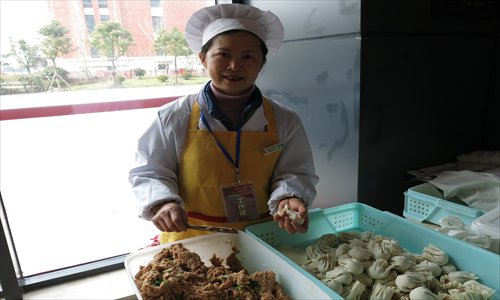Shaomai special
Xiasha variety of popular Shanghai snack is still going strong, despite pale imitations
Editor's Note
According to UNESCO's definition, an "intangible cultural heritage" includes traditions or living expressions inherited from our ancestors and passed on to our descendants, such as oral traditions, performing arts, social practices, rituals, festive events, knowledge and practices concerning nature and the universe or the knowledge and skills to produce traditional crafts. It has to be traditional, contemporary and living at the same time, inclusive, representative, and community-based. The safeguarding of intangible cultural heritage is an important factor in maintaining cultural diversity in the face of growing globalization. An understanding of the intangible cultural heritage of different communities helps with intercultural dialogue, and encourages mutual respect for other ways of life.
The Shanghai municipal government has designated 157 traditions as Shanghai's intangible cultural heritage. The Global Times Metro Shanghai culture page will introduce one intangible culture heritage and interview their current inheritors every month.
Chinese dim sum is an integral part of Chinese food culture. Xiasha shaomai, a Shanghai specialty dim sum, was listed as a district-level intangible culture heritage in Pudong New Area in 2011.
Shaomai are a kind of steamed dumpling shaped like a peach blossom, stuffed with glutinous rice and meat. They are popular in northern and eastern cities, and their origin can be traced back to the Yuan Dynasty (1279-1368). Xiasha shaomai differ from typical shaomai in that their salty variety is made with bamboo shoots and pork as stuffing, while the sweet varieties use red bean paste and pips as stuffing.
Xiasha shaomai date back to the Ming Dynasty (1368-1644), when residents of the Xiasha community of Hangtou town, Pudong area, rewarded imperial troops who defended them from pirate attacks with the delicacies. When the troops asked what the snacks were, the local residents joked that, since they were made and cooked while being sold, they were called shaomai (shao means "cook" and mai means "sell"). It became a custom for local residents to eat shaomai while attending the temple fair every March.
Zheng Yuxia (pictured below) is a fourth-generation inheritor of the skill of making Xiasha shaomai, having learned it from her mother. Now she is passing the skills on to her son.

Zheng told the Global Times that good Xiasha shaomai use secret seasonings and fresh bamboo shoots and pork.
Previously, the snacks would only be available for two months of the year, as Zheng and her mother insisted on only using fresh ingredients available around that time. It was not until 2013 that Zheng started to use winter bamboo shoots to make the stuffing, extending the sales period to the seven months from December to June.
Last year, Zheng started making new varieties of the snack with different fillings such as corn and carrot, for use when bamboo shoots are unavailable.
In the era of Zheng's mother, Zhou Lijuan, the shaomai were sold at Xiasha Restaurant where Zhou worked as the manager. Since the dim sum were so popular, Zhou set up her own snack bar to sell them after she retired. Now the mother and daughter own a chain of eight outlets selling the shaomai around the city.
Imitators have sprung up, even using the name Xiasha shaomai, and undercutting the price of the originals. While Zheng prices her shaomai at 3.5 yuan ($0.56) each, other shops sell for 3 yuan.

But Zheng believes that those imitators' shaomai are probably made with gutter oil and unqualified meat, and cannot compete with hers. According to Zheng, she only accepts pork as entire hams from suppliers rather than as small blocks of meat that cannot be traced. She only uses fresh meat and bamboo shoots rather than frozen.
Meanwhile, the sweet Xiasha shaomai use dahongpao red bean paste mixed with walnut, seeds and tangerine peel as stuffing.
The outer, peach blossom-shaped wrapper of shaomai are handmade, with a relatively thick base to prevent the snacks from breaking when held at the top by chopsticks. When steamed, the tip of the wrapper opens up to resemble a peach blossom.
Zheng quickly rotates the flattened wrapper as she puts in the stuffing, then nips the neck together with her fingers. Without any measuring tool, Zheng can ensure that each shaomai weighs around 50 grams.
According to Zheng, a skillful chef can make more than 100 pieces of shaomai in 10 minutes. As the shaomai were only produced for around two months of each year, Zheng had trouble finding apprentices willing to learn such a skilled task that would only be useful for a limited amount of time.

Zheng Yuxia teaches students how to make shaomai. Photos: Du Qiongfang/GT
However, since inventing more varieties of shaomai that can be made the whole year through, it has been easier to find willing recruits. Her son, who is a sculpture graduate of Shanghai University, has joined the family business, and designed the logo for their trademark.
Xiasha shaomai are enjoyed by many foreign customers. "Many foreigners don't know how to eat shaomai. They hold the shaomai upside down, so the juice spills through the opening. I taught them to keep the opening up and bite a little bit on the bottom first, then suck the juice into the mouth so it doesn't spill everywhere," said Zheng.